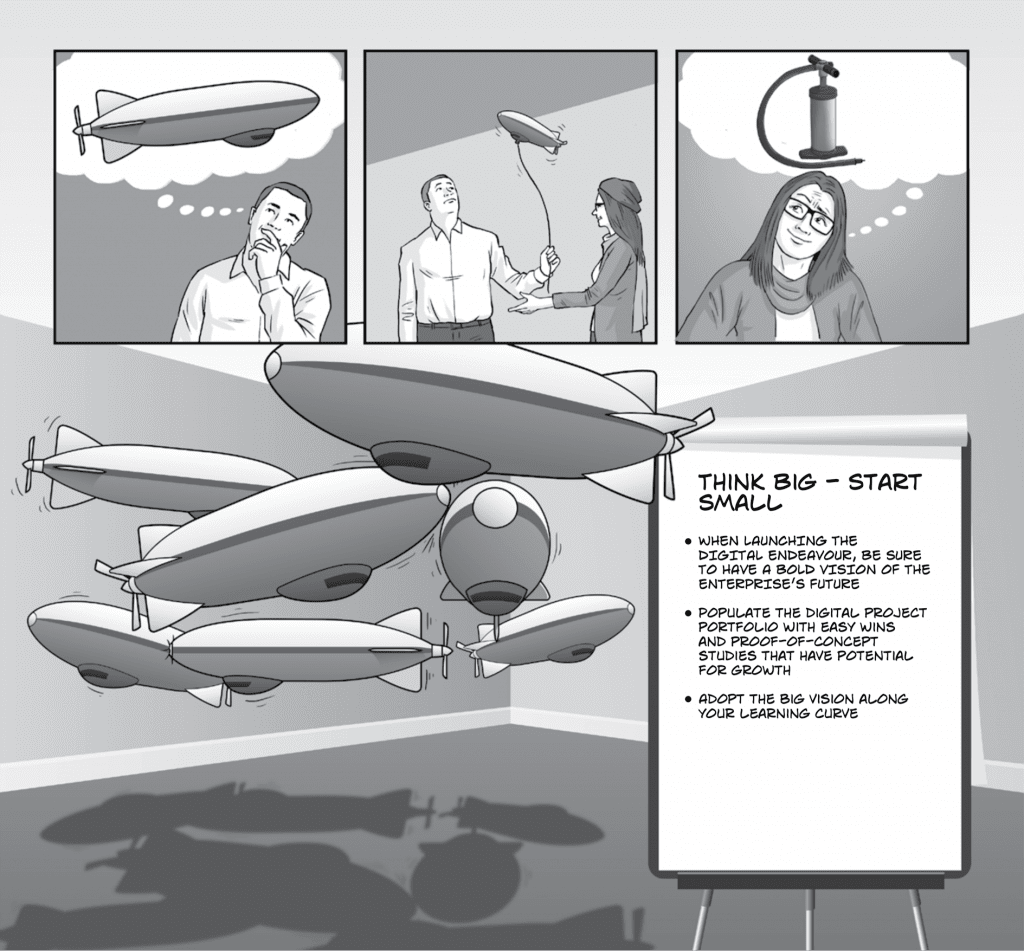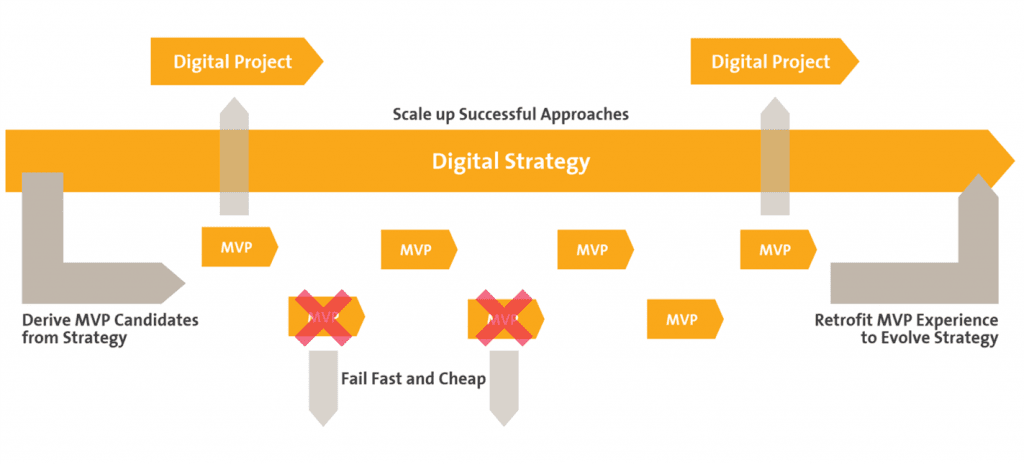Companies seeking to pursue digital often proceed from very different starting points, with different capabilities, circumstances and degrees of ambition. Some will require a full transformation of their operations, processes and business model in order to fully leverage digital technology and drive revenue. Others may only need to increase efficiency by re-engineering their existing business and operating models.
Given the fact that defining a strategy takes valuable time, it is key to start early on with real projects, even before a strategy has been fully defined.
In addition to that, a top-down approach can never foresee everything, and therefore starting with an incomplete transformation plan that evolves over time is inevitable.
Regardless of how ambitious their digital initiative is, companies should start with quick wins in at least one of several areas, for example improving the customer experience while at the same time digitising internal processes.
As an illustration of how businesses are enhancing the customer experience, some energy companies are starting to offer mobile apps that allow customers to check bills and obtain meter data. More advanced offerings from retail chains allow customers to keep track of shopping lists, or even share lists among family members for them to add items, and order out-of-stock items through an e-commerce portal on their smartphone. Some of these customer facing improvements go hand in hand with optimised and simplified internal processes.
Another approach to benefiting from the digital mindset and technology is to improve internal processes and functions, such as finance or HR.
This approach is particularly relevant for B2B (business to business) companies, which place less emphasis on the end-customer experience. Digital technologies can improve the efficiency and accuracy of processes and thereby reduce costs, and they allow the company to run data-driven analytics to first analyse and then improve performance over time.
Whether a company begins its digital transformation by improving the customer experience or improving internal processes, speed is critical. Instead of taking the traditional, linear approach to rolling out new initiatives, companies should bring new ideas to market early on, collect customer feedback and refine the concept iteratively. Many accomplish this by means of the minimum viable product (MVP) process of prototyping.
The MVP process is based on the idea of the ‘good enough’ product. Rather than trying to perfect new services internally during the development stage, the company instead aims at getting them to market quickly, with just enough features included to make them functional. That allows the company to minimise its investment, test the functionalities and services in the real world (instead of in artificial settings such as focus groups) and refine them based on customer feedback. For example, the initial versions of apps and online stores are often quite basic, with new features and functions added over time, depending on how the products are used by customers.
The following example nicely illustrates this approach: A multinational big-box retailer operating in an emerging market launched a quick-win initiative with a mobile app to boost declining sales at its physical stores. Rather than develop a grand digital strategy or conduct detailed market research to determine the scope of the opportunity, the retailer outsourced the entire app development process so it could build something for the market quickly. When the app turned out to be a successful idea, customer-friendly features were added to the app, such as personalised coupons and offers, tools to plan shopping trips, automatic replenishment of regular purchases (through a subscription model) and even in-store navigation. It resonated strongly with customers and led to increased sales at the retailer’s stores, especially once management learned what worked well and continued to add new features, such as in-store WiFi and home delivery of goods purchased online.
It is important to note that we do not view a strategy as useless. The opposite is true. We strongly encourage companies to define a digital strategy.
A strategy gives direction and a preselection of approaches that fit the enterprise in terms of its values, know-how or synergy. But in no circumstances should the strategy definitions slow down the transformation. The MVP approach allows a validation of the strategy and gives the opportunity to try out transformation steps. The goal is to proceed in those small steps, see what works, encounter failure as quickly as possible and adjust the strategy.
Enterprises have three major challenges to making an MVP approach successful:
Firstly, enterprises must choose projects that have respective growth potential. Remember that the ultimate goal of digitalisation is to turn around the way a company works as a whole, including operational procedures and business models. This can only be achieved with ideas that have the potential to deliver a notable contribution over the long run. Therefore, every project should have its path to achieving scale sketched out before it is started.
Secondly – and this is quite a challenging step for many enterprises – you must free resources by abandoning ideas that appear not to be taking off. Even projects explicitly started to prove the viability of a business idea are hard to stop when they do not deliver the desired results. This is because projects are staffed with people who have their own personal agendas. It is therefore essential to establish rigid governance that supervises the outcome of MVP projects and implements the fail fast principle.
Finally, enterprises face the challenge of scaling up the most promising ventures. Several levers are available to accomplish this. The right one depends on the company’s level of ambition, the strength of its existing digital capabilities and external market factors (primarily the degree of disruption posed by new digital competitors). For example, one way to scale up digital initiatives is to acquire digital talent on a temporary basis and then bring it in-house over time.
As the company embeds talent, it can create digital units that serve as a centre of excellence.


